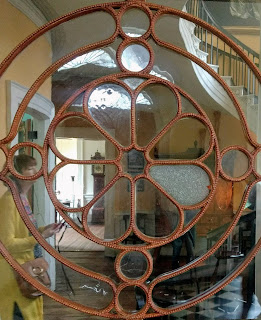Our tour guide recommended seeing this mansion in Charleston, the Nathaniel Russell House. This house was built by Nathaniel Russell in 1808.
All the current furniture is from the period, and the restorers did a good job figuring out what wall paints to use, carpet, furniture, etc... The molding and wood work is all original. The thing that stands out is the free-standing circular staircase, all put together with pegs. Part of the staircase underneath has been exposed to see how it was built. All this fine work was performed by Charleston enslaved Africans.
This house has internal shutters instead of external ones. They have cool latches that hold back all 4 sections with a single lever.
I asked why in these old portraits the people sometimes have their hand in their vest - the docent said that they think the reason is often because the hand is difficult to draw and so the painter prefers to skip this part :)
Real gold leaf in the ceiling molding.
We also saw the the slave sleeping room and kitchen. They are currently trying to uncover clues of how these areas looked before renovating them as well. We hear here the same very sad stories of how slave life took place in these houses and in town, and how the wealth and lavish lifestyle of these rich people came primarily from the trade, labor, and exploitation of the enslaved people.
For lunch we went to the only purely vegan restaurant in Charleston, the Gnome. It was a fantastic meal!!!
Next we visited the Exchange and Provost. This building was constructed on the original walls of the city on some landfill in 1767 - it was a center for town business since it was a very prominent structure along the river, attracting boats that would doc near it on the shore, and allowed transport of merchandise/people from river to town and vice versa. The bottom floor, called the dungeon, was used as a prison during the revolutionary war when England retook the city in 1780 for a couple of years. Also the English stored tea in the dungeon that the townspeople refused to buy due to the taxes (like Boston). Once the English were gone the townspeople used sales of the tea to finance the revolutionary war effort. Upstairs there are exhibits for the revolutionary war and civil war. The building was also used for slave auctions.
 |
| Emanuel African Methodist Episcopal Church |
 |
| Fixer-upper |
 |
| Folly Beach warf |






















No comments:
Post a Comment